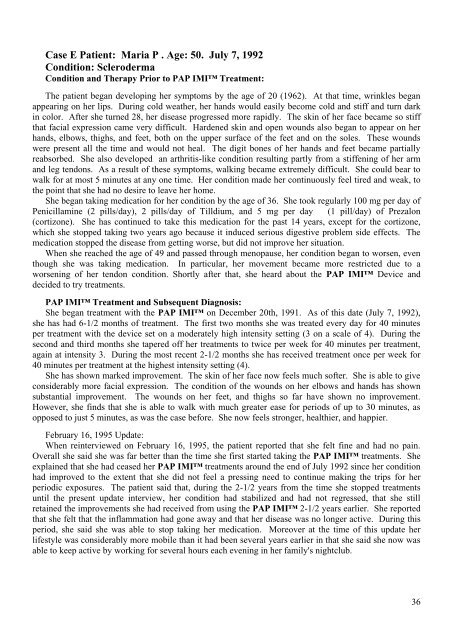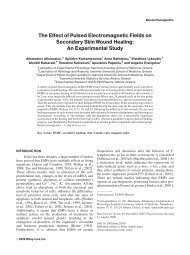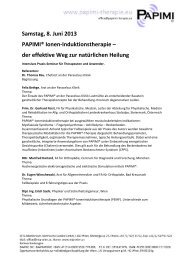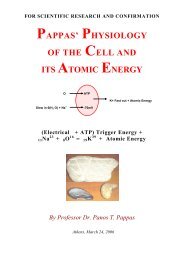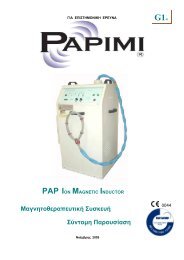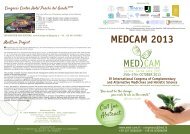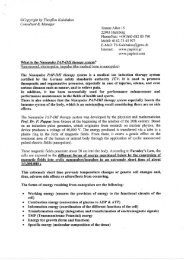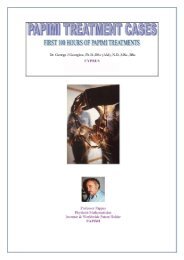Cases from private practices - Papimi
Cases from private practices - Papimi
Cases from private practices - Papimi
Create successful ePaper yourself
Turn your PDF publications into a flip-book with our unique Google optimized e-Paper software.
Case E Patient: Maria P . Age: 50. July 7, 1992<br />
Condition: Scleroderma<br />
Condition and Therapy Prior to PAP IMI Treatment:<br />
The patient began developing her symptoms by the age of 20 (1962). At that time, wrinkles began<br />
appearing on her lips. During cold weather, her hands would easily become cold and stiff and turn dark<br />
in color. After she turned 28, her disease progressed more rapidly. The skin of her face became so stiff<br />
that facial expression came very difficult. Hardened skin and open wounds also began to appear on her<br />
hands, elbows, thighs, and feet, both on the upper surface of the feet and on the soles. These wounds<br />
were present all the time and would not heal. The digit bones of her hands and feet became partially<br />
reabsorbed. She also developed an arthritis-like condition resulting partly <strong>from</strong> a stiffening of her arm<br />
and leg tendons. As a result of these symptoms, walking became extremely difficult. She could bear to<br />
walk for at most 5 minutes at any one time. Her condition made her continuously feel tired and weak, to<br />
the point that she had no desire to leave her home.<br />
She began taking medication for her condition by the age of 36. She took regularly 100 mg per day of<br />
Penicillamine (2 pills/day), 2 pills/day of Tilldium, and 5 mg per day (1 pill/day) of Prezalon<br />
(cortizone). She has continued to take this medication for the past 14 years, except for the cortizone,<br />
which she stopped taking two years ago because it induced serious digestive problem side effects. The<br />
medication stopped the disease <strong>from</strong> getting worse, but did not improve her situation.<br />
When she reached the age of 49 and passed through menopause, her condition began to worsen, even<br />
though she was taking medication. In particular, her movement became more restricted due to a<br />
worsening of her tendon condition. Shortly after that, she heard about the PAP IMI Device and<br />
decided to try treatments.<br />
PAP IMI Treatment and Subsequent Diagnosis:<br />
She began treatment with the PAP IMI on December 20th, 1991. As of this date (July 7, 1992),<br />
she has had 6-1/2 months of treatment. The first two months she was treated every day for 40 minutes<br />
per treatment with the device set on a moderately high intensity setting (3 on a scale of 4). During the<br />
second and third months she tapered off her treatments to twice per week for 40 minutes per treatment,<br />
again at intensity 3. During the most recent 2-1/2 months she has received treatment once per week for<br />
40 minutes per treatment at the highest intensity setting (4).<br />
She has shown marked improvement. The skin of her face now feels much softer. She is able to give<br />
considerably more facial expression. The condition of the wounds on her elbows and hands has shown<br />
substantial improvement. The wounds on her feet, and thighs so far have shown no improvement.<br />
However, she finds that she is able to walk with much greater ease for periods of up to 30 minutes, as<br />
opposed to just 5 minutes, as was the case before. She now feels stronger, healthier, and happier.<br />
February 16, 1995 Update:<br />
When reinterviewed on February 16, 1995, the patient reported that she felt fine and had no pain.<br />
Overall she said she was far better than the time she first started taking the PAP IMI treatments. She<br />
explained that she had ceased her PAP IMI treatments around the end of July 1992 since her condition<br />
had improved to the extent that she did not feel a pressing need to continue making the trips for her<br />
periodic exposures. The patient said that, during the 2-1/2 years <strong>from</strong> the time she stopped treatments<br />
until the present update interview, her condition had stabilized and had not regressed, that she still<br />
retained the improvements she had received <strong>from</strong> using the PAP IMI 2-1/2 years earlier. She reported<br />
that she felt that the inflammation had gone away and that her disease was no longer active. During this<br />
period, she said she was able to stop taking her medication. Moreover at the time of this update her<br />
lifestyle was considerably more mobile than it had been several years earlier in that she said she now was<br />
able to keep active by working for several hours each evening in her family's nightclub.<br />
36


